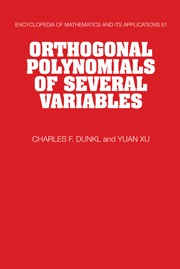Book contents
- Frontmatter
- Contents
- Preface
- 1 Background
- 2 Examples of Orthogonal Polynomials in Several Variables
- 3 General Properties of Orthogonal Polynomials in Several Variables
- 4 Root Systems and Coxeter groups
- 5 Spherical Harmonics Associated with Reflection Groups
- 6 Classical and Generalized Classical Orthogonal Polynomials
- 7 Summability of Orthogonal Expansions
- 8 Orthogonal Polynomials Associated with Symmetric Groups
- 9 Orthogonal Polynomials Associated with Octahedral Groups and Applications
- Bibliography
- Author index
- Symbol index
- Subject index
6 - Classical and Generalized Classical Orthogonal Polynomials
Published online by Cambridge University Press: 17 December 2009
- Frontmatter
- Contents
- Preface
- 1 Background
- 2 Examples of Orthogonal Polynomials in Several Variables
- 3 General Properties of Orthogonal Polynomials in Several Variables
- 4 Root Systems and Coxeter groups
- 5 Spherical Harmonics Associated with Reflection Groups
- 6 Classical and Generalized Classical Orthogonal Polynomials
- 7 Summability of Orthogonal Expansions
- 8 Orthogonal Polynomials Associated with Symmetric Groups
- 9 Orthogonal Polynomials Associated with Octahedral Groups and Applications
- Bibliography
- Author index
- Symbol index
- Subject index
Summary
In this chapter we study orthogonal polynomials that generalize the classical orthogonal polynomials in the sense that they satisfy a second order differential–difference equation. They are orthogonal with respect to weight functions that contain a number of parameters, and they reduce to the classical orthogonal polynomials when some of the parameters go to zero. Explicit formulae for reproducing kernels are derived for some families of orthogonal polynomials.
Generalized Classical Orthogonal Polynomials on the Ball
The classical orthogonal polynomials on the ball Bd are discussed in Subsection 2.3.2.
Definition and differential–difference equations
Definition 6.1.1 Let hK be a reflection invariant weight function as in Definition 5.1.1. Define a weight function on Bd by
The polynomials that are orthogonal to W∧ are called generalized classical orthogonal polynomials on Bd.
Recall that c′h is the normalization constant for h2 K over S∧1; it follows from the polar coordinates that the normalization constant of W∧ is given by
where crd-i is the surface area of Sd~1, jK is the homogeneous degree of hK. Again we shall write 7 for 7∧ in the proofs. If K - 0 or W being the orthogonal group, then hK(x) = 1 and the weight function W∧(x) is reduced to W∧(x) = (1 - \\x\\2Y-∧2, the weight function of the classical orthogonal polynomials on the ball.
We study these polynomials by relating them to /i-harmonics. Recall Theorem 3.8.4 which gives a correspondence between orthogonal polynomials on Bd and those on Sd.
- Type
- Chapter
- Information
- Orthogonal Polynomials of Several Variables , pp. 225 - 254Publisher: Cambridge University PressPrint publication year: 2001



